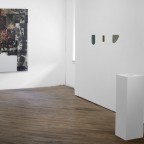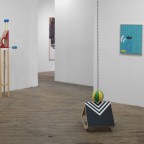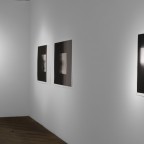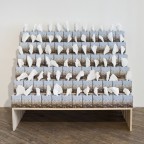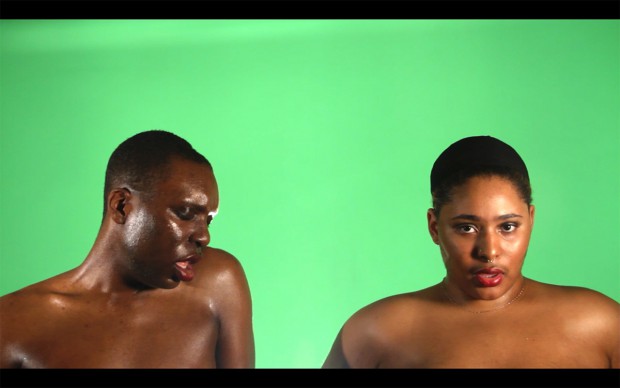
VOX XI: Material Studies features work by Roxana Azar (Meadowbrook, PA), Kyle Bauer (Baltimore), Julia Brown (Washington, DC), Kat Chamberlin (Brooklyn, NY), Lisa Dillin (Baltimore), Alex Ebstein (Baltimore), J. Michael Ford (Chicago), Lauren Francescone (Brooklyn, NY), Samuel Hindolo (Philadelphia), Zack Ingram (Baltimore), Lauren Pakradooni (Philadelphia), Amina Ross (Chicago), Paul Salveson (Philadelphia, PA), and Amy Yee (Baltimore). There will be a gallery talk on Sunday, July 26th at 3pm.
The jurors of VOX XI are Paddy Johnson and Martine Syms.
Exhibition Statement, by Paddy Johnson
This year Vox Populi received 365 applications for its juried show, which marks the largest mass of artwork I have ever had the privilege of discussing as a juror. Most of those applicants were artists whose work I was either wholly or mostly unaware of before the open call.
Martine Syms and I spent three days reviewing the applications. That involved not just looking at slides, but reviewing artist statements and CV’s. And since we did the work remotely, I often took extra time to review artist websites as well. That approach is very different than the average curated show, which–for better or worse–is almost always built on a curator’s network of connections. Juried shows force the introduction of new work to their curators.
What juried shows don’t typically do is produce highly focused thematic shows. When Martine and I evaluated the works submitted, we weren’t evaluating how well the work fit within a specific subject, but simply how well it functioned as a(n?) (documented) object. Is the craft accomplished? Is there a solid conceit? We also considered whether the artist had an active exhibition history.
We named the show after the most visible constant in the exhibition: Material Studies. And thus, VOX XI: Material Studies was born.
The form these studies take couldn’t be more diverse. Lisa Dillin’s sculptures examine the dichotomy between the natural and artificial; Roxana Azar’s photography explores the relationship between the digital and analogue world. Meanwhile, Kyle Bauer’s free-standing sculptures use materiality to explore balance, tension and control; appearing as though they were inspired by circus props.
Some works simply explore formal beauty. Alex Ebstein’s large-scale paintings are studies in balance, shape, and line in abstraction, and Lauren Pakradooni creates printed abstract sculptures that reference the domestic sphere. J. Michael Ford bends wire to create large-scale sculptures adorned with seemingly random elements: flowers, mop threads, feathers, and so forth. They are a delight to look at. And Zack Ingram modulates material simply:a silver sheet pours out from the center of a canvas; a teal frame holds a grey bit of fabric to capture the viewer’s attention.
In many cases, material is used to investigate identity and the political. Julia Brown applies the operation of a test strip to historical photographs of interracial encounters to allude to the chemical printing process that produces an “optimal white density” for the final print. In doing so, Brown seems to be asking: is there an optimal white density of skin color as well? Samuel Hindolo similarly explores race through photography. He uses images of black bodies and collages them onto canvas via photo transfer. Meanwhile, Amina Ross uses installation and video to create a tension between repulsion and seduction. Two black performers, male and female and naked from the chest up, cycle through emotions by repeating charged phrases like “Do you remember” “it won’t hurt a bit” each time changing the intonation and thus the meaning. A green screen behind the two further suggests the mutability of emotion.
Some of the show’s common themes are material mimicry and allusion. Lauren Francescone works with glazed stoneware to produce objects like stone iPhone cases. Alternately, Amy Yee created a pyramid of tissue boxes she found adorned with prints of wheat blowing in the wind. She pulls a tissue out in each box, as if they were flowers.
And then there are those who employ language in the creation of their work. Paul Salveson’s instruction video tells viewers how he uses wire tools to clear what look like coffee grinds from the floor, and then later re-scatter them. Salveson’s dry instructions make sly reference to Sol LeWitt. By contrast, Kat Chamberlin’s circling of bizarre newspaper clippings of horoscopes and classifieds simply creates a feeling of unease or the uncanny.
That uncanny feeling permeates? the show, imbuing even the most abstract pieces with a sense of otherworldliness. And for a show exploring material transformation, that seems fitting.
Juror biographies
Paddy Johnson (NYC) is the founding Editor of Art F City and maintains a column on digital art for Artnet. In addition to her work on the blog, she has been published in magazines such as New York Magazine, The New York Times and The Economist. Paddy lectures widely about art and the Internet at venues including Yale University, Parsons, Rutgers, South by Southwest, and the Whitney Independent Study Program. In 2007 she received a scholarship to attend iCommons conference in Croatia as the art critic. In 2008, she served on the board of the Rockefeller Foundation New Media Fellowships and became the first blogger to earn a Creative Capital Arts Writers grant from the Creative Capital Foundation. Paddy was nominated for best art critic at The Rob Pruitt Art Awards in 2010 and 2013. In 2014, she was the subject of a VICE profile for her work as an independent art blogger.
Martine Syms (LA) is a conceptual entrepreneur based in Los Angeles who uses publishing, video, and performance to look at the making and reception of meaning in contemporary America. She currently runs DOMINICA, an imprint dedicated to exploring blackness as a topic, reference, marker and audience in visual culture. From 2007–11, Syms directed Golden Age, a project space focused on printed matter. She has presented work at universities and museums internationally.


